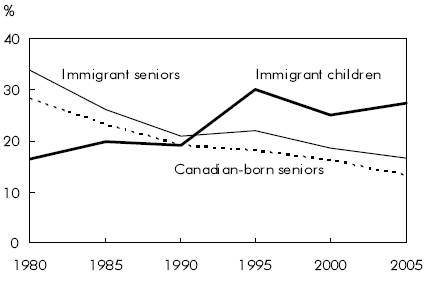Common menu bar links
Quiz
Archived Content
Information identified as archived is provided for reference, research or recordkeeping purposes. It is not subject to the Government of Canada Web Standards and has not been altered or updated since it was archived. Please "contact us" to request a format other than those available.
To the question: The low-income rate has been rising among the immigrant population as a whole, but one immigrant group saw its low-income rate fall over the past quarter century. Which group is it?
A. Immigrant children, or B. Immigrant seniors
The correct answer is B: The low-income rate among immigrant seniors was cut in half between 1980 and 2005, from 34% to 17%, which is only marginally higher than the rate among Canadian-born seniors, whose low-income rate was 13%.
In contrast, 27% of immigrant children lived in low-income families in 2005, up from 16% in 1980. This increase occurred while the rate among Canadian-born children was falling.
The low-income rate among immigrant seniors fell because they lived in families with higher market income (mostly income from employment), and because government social transfers reduced low-income rates among seniors as a whole. But in the case of immigrant seniors, the effect of rising market income was larger.
Chart - Low-income rates among immigrant children and seniors

Source: Census of Canada, 20% sample microdata files, 1981 to 2006.
Low-income rates are based on the total family income of seniors. If, for example, immigrant seniors were more likely to live in multi-generational families with more younger earners in 2005 than in 1980, this would be reflected in the rising market income available to them.
![]() Table - Low-income rates among immigrant children and seniors
Table - Low-income rates among immigrant children and seniors
Source: Immigrant low-income rates: The role of market income and government transfers - HTML | PDF

